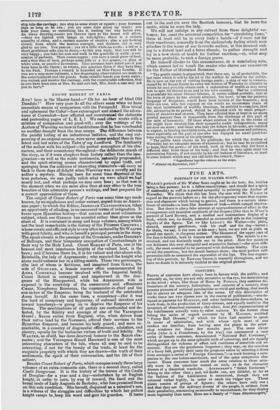FINE ARTS.
PORTRAIT OF SIR WALTER SCOTT.
Witartes portrait of Sir Walter Scott ought te be the best ; for, besides being a fine painter, he is a fellow-counti-min, and should feel a spirit of nationality as well as a poetical sympathy in painting the Author of Waverley. We think that this has been the case with Mr. WILKIE in regard to the portrait before us ; for the physiognomy wears that expres- sion and character which belong to genius, and there is a certain state- liness of attitude—a bust-like fixedness of look—which compel observa- tion. But there is also a false attempt at aggrandizement of effect in the arrangement and excessive amplitude of the drapery (like that in WEST'S portrait of Lord Byron), and a studied and ostentatious display of a book, which are, no doubt, intended as accessorial aids to the imposing dignity of the figure. Yet we like LESLIE'S Sir Walter—the plain, shrewd, country gentleman, with his staff and his dog—better : for there, we say, is the man at his ease ; here, we are told as plain as pencil can speak, is the great author. The likeness of the upper Tart of the face is faithful, both in feature and expression. The mouth is c m- strained, and not distinctly made out in the print. How few paintsrs can delineate this ever changeful and expressive feature l—the most diffi- cult, the most essential to be portrayed with delicate fidelity. The eyes reveal the emotions, but the mouth betrays them; the most perfect self- possession fails to command the expression of the lips. The line engrav- ing of this portrait, by EDWARD SMITH, is masterly throughout, and we have no doubt it is minutely faithful to the original picture.


























 Previous page
Previous page